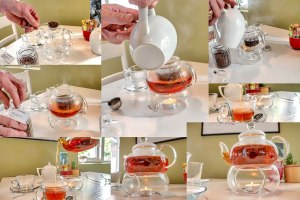 The coming weeks we introduce you to about 25 different natural health teas (without added flavours and other additives). Here the third part of the introduction. All teas at Yum Eat Cafe are served in-fusion.
The coming weeks we introduce you to about 25 different natural health teas (without added flavours and other additives). Here the third part of the introduction. All teas at Yum Eat Cafe are served in-fusion.
Hand methods for the preparation of tea shoots, consisting of the young leaves and terminal leave bud, have their origin in antiquity. Tea is designated as black (fermented), green (unfermented), or oolong (semi-fermented), depending upon the process applied. Green tea is produced mainly in China, Japan and Taiwan, but 98 percent of the international trade is in black tea.
When black tea is made by the small producer, the leaf is plucked on a clear day after the dew is gone, exposed to the sun and air for at least an hour, then lightly rolled on a table to develop a red colour and an aroma. The leaves are heated in a hot iron pan, rolled, heated several additional times, and finally dried in a basket over a charcoal fire. With China mechanizing its industry, China teas may retrieve their importance in the world markets.
In China, green tea is made by heating the freshly plucked leaves in an iron pan for a few minutes, causing the leaves to turn yellow, inactivating the enzymes, and killing the leaves. It is then hand rolled and given further roastings, which turn it to olive green and then to a bluish tint. In Japan, where most of the crop is made into green tea, the leaf is heated by steam, and modern machines perform the rolling and drying.
Oolong, semi-fermented tea, is prepared in South China and Taiwan from a special form of China plant, chesima, that gives this tea unique flavour. Preparation is similar to that followed in making China black tea. Both China and oolong teas are sometimes scented with flowers, such as Jasmine.
Brick tea, made in China for export to inner Asia, is of little importance in world trade. It may consist of leaf, stalk and even twigs, or mainly of tea dust and fannings (coarse tea dust). The bulk is softened with steam and then compressed into blocks or bricks.
In Burma, Thailand and China, the tea leaf may be pickled and the product, which is called lappet-so, eaten as a vegetable.
Hi,
I really enjoyed reading this post an informative read, thank you.
http://pinkiebag.com/
LikeLiked by 1 person
😀
LikeLiked by 1 person
I love the calming process of preparing tea!
LikeLiked by 1 person
😀
LikeLike